I mentioned "magic wash" in my Painting the Troops post, but I didn't mention what it was. Magic wash is basically a wash that uses Future floor wax (or its equivalent outside the US, see the link for more info) as part of the mixture.
I've seen similar formulas described elsewhere, but the first time I saw it referred to as "magic wash" was on the Flames of War forums, and most of what I know about it comes from posts made there.
The exact ratio of wax to ink to water varies tremendously. The mix I currently use is 3 parts water to 1 part Future to 1 part GW ink. I've seen ratios that call for much less ink (just enough to get a shade). I've seen ratios that use much less water, even to the point of just being wax and ink. As with most painting techniques, the best thing to do is to just experiment.
I make the mixture in an empty Vallejo paint bottle for easier use and storage.
The purpose of the "magic wash" is the same as any other wash, but the Future helps break surface tension which lets it flow more freely into crevices and depressions on a miniature with less pooling on flat surfaces. The result helps bring out details while helping to smooth transitions between different areas of color on the miniature.
I've only used the method on 15mm miniatures so far, but I plan on giving it a try on some larger scale stuff later to see how it does.
I've found with my Soviet infantry that it really helps cut down on my painting time, but I'll go more into that when I can take some pictures of the infantry I've gotten painted so far.
Tuesday, June 27, 2006
Thursday, June 22, 2006
Book Review: Across the Dark Islands: The War in the Pacific
Across the Dark Islands is a memoir of Floyd W. Radike's WWII experiences which began as a platoon commander reinforcing Guadalcanal and ended in administrative duties in the Philippines on VP day followed by a short time occupying Japan. The story he tells is an interesting contrast to those told by members of elite Army units such as the paratroopers in Band of Brothers. Radike was not a member of such an elite unit, he was a member of a pre-war National Guard unit used to fill out a Regular Army division.
Radike himself was an outsider in the regiment having been reassigned after attending infantry school. Most of the officers in the regiment had spent years together in the National Guard and the result, according to Radike, was not the most efficient system of selecting combat commanders. Radike describes a unit with few quality officers that suffered from either incompetent National Guard leaders or overly ambitious Regular Army officers at different times in its history. It would be easy to dismiss these criticisms as the whining of a troublemaker, but Radike went on to achieve the rank of Brigadier General in the National Guard following the war, so you have to assume that he wasn't just a square peg in the Army organization.
Despite being utilized in mostly lower-risk assignments on Guadalcanal, Radike's regiment still suffered over 80% casualties due to disease and the environment. Many of the older National Guard soldiers simply couldn't take the heat and had to be sent home. Even though they weren't used as a spearhead in the fighting, Radike's company still saw its share of combat casualties before the Japanese were finally evicted from the island.
After the defeat of the Japanese on Guadalcanal Radike spent time in various duties on the island before being sent with the regiment to New Georgia where they were involved in more fighting that cost Radike his company CO and best friend in the regiment. After New Georgia the regiment was pulled out for rebuilding and sent to New Zealand and later New Caledonia before beign sent back into action in the Philippines.
Radike's unit participated in the fighting on the main island on Luzon, including the fight against the Japanese 2nd Armored Division which provides a short look at some of the armored warfare that went on in the Pacific theatre. Eventually Radike was transferred to the rear echelon after being wounded and the rest of the book covers his experiences there and in occupied Japan.
As a memoir, the book does not provide a good overview of the entire war or the specific importance of the campaigns Radike participated in to the Pacific Theatre. For that reason I recommend it to the intermediate student of the war who already has a general knowledge of the overall conflict and can better see how Radike's experiences fit into that picture.
The book does provide a good look at the experience of a nationalized National Guard unit in the Pacific Theatre and many of the problems that such a unit faced both from the enemy and its own organization.
From a gamer's perspective there's not a lot here in the way of organization detail or specifics that can be used to build scenarios. The maps are few and general and don't serve to show the location of the specific incidents Radike was involved in. They are also merely geographical in nature and do not show any military movements. There is some interesting information on the fight with the 2nd Armored Division which could probably be used to generate some interesting scenarios.
The book only contains two pictures. One on the front cover which has no caption or attribution that I could find and one of the author in his uniform following his commissioning ceremony. As a memoir, it contains no bibliography. It also lacks an index. Fortunately, there is a serviceable table of contents and the book is not overly long. I had little trouble finding things again in order to write this review.
I would recommend this book to anyone with an interest in the experience of the average GI in the Pacific. Not the Medal of Honor winner or the guy who helped raise the flag on Iwo Jimo, but the average Joe who formed the bulk of the troops fighting in the Pacific.
Radike himself was an outsider in the regiment having been reassigned after attending infantry school. Most of the officers in the regiment had spent years together in the National Guard and the result, according to Radike, was not the most efficient system of selecting combat commanders. Radike describes a unit with few quality officers that suffered from either incompetent National Guard leaders or overly ambitious Regular Army officers at different times in its history. It would be easy to dismiss these criticisms as the whining of a troublemaker, but Radike went on to achieve the rank of Brigadier General in the National Guard following the war, so you have to assume that he wasn't just a square peg in the Army organization.
Despite being utilized in mostly lower-risk assignments on Guadalcanal, Radike's regiment still suffered over 80% casualties due to disease and the environment. Many of the older National Guard soldiers simply couldn't take the heat and had to be sent home. Even though they weren't used as a spearhead in the fighting, Radike's company still saw its share of combat casualties before the Japanese were finally evicted from the island.
After the defeat of the Japanese on Guadalcanal Radike spent time in various duties on the island before being sent with the regiment to New Georgia where they were involved in more fighting that cost Radike his company CO and best friend in the regiment. After New Georgia the regiment was pulled out for rebuilding and sent to New Zealand and later New Caledonia before beign sent back into action in the Philippines.
Radike's unit participated in the fighting on the main island on Luzon, including the fight against the Japanese 2nd Armored Division which provides a short look at some of the armored warfare that went on in the Pacific theatre. Eventually Radike was transferred to the rear echelon after being wounded and the rest of the book covers his experiences there and in occupied Japan.
As a memoir, the book does not provide a good overview of the entire war or the specific importance of the campaigns Radike participated in to the Pacific Theatre. For that reason I recommend it to the intermediate student of the war who already has a general knowledge of the overall conflict and can better see how Radike's experiences fit into that picture.
The book does provide a good look at the experience of a nationalized National Guard unit in the Pacific Theatre and many of the problems that such a unit faced both from the enemy and its own organization.
From a gamer's perspective there's not a lot here in the way of organization detail or specifics that can be used to build scenarios. The maps are few and general and don't serve to show the location of the specific incidents Radike was involved in. They are also merely geographical in nature and do not show any military movements. There is some interesting information on the fight with the 2nd Armored Division which could probably be used to generate some interesting scenarios.
The book only contains two pictures. One on the front cover which has no caption or attribution that I could find and one of the author in his uniform following his commissioning ceremony. As a memoir, it contains no bibliography. It also lacks an index. Fortunately, there is a serviceable table of contents and the book is not overly long. I had little trouble finding things again in order to write this review.
I would recommend this book to anyone with an interest in the experience of the average GI in the Pacific. Not the Medal of Honor winner or the guy who helped raise the flag on Iwo Jimo, but the average Joe who formed the bulk of the troops fighting in the Pacific.
Tuesday, June 20, 2006
Book Review: Panzer Tactics
Panzer Tactics: German Small-Unit Armor Tactics In World War II is by Wolfgang Schneider, an officer in the modern Bundeswehr (German Army), and someone who is developing a reputation as an historian of WWII. The book outlines tactics used at the battalion, company and platoon levels of a German armored formation.
The author does this by making use of Wehrmacht training manuals and of first hand accounts gathered "through hours of discussion with former Panzer soldiers of all ranks, evaluation of combat reports and accounts of personal experiences" along with his own experience as an officer in the modern Bundeswehr. Unfortunately, we have to mostly take his word for this as the book completely lacks a bibliography or footnotes of any kind.
What it does have is a large number of excellent photographs and reproductions of pages from Wehrmacht training manuals. I didn't do an exact page count, but it would appear that over half of the 352 page book consists of photographs, many used to depict the topics covered in the writing.
I found the pages from the training manuals and their accompanying translations are particularly useful in presenting basic tactical concepts.
The main topics covered include the following taken from the table of contents: Offensive Operations, Defensive Operations, Unit Movements, Reconnaissance, Command and Control, Logistics and Maintenance, Combined Arms Operations, Life in a Tank, Training and Tank Gunnery, and Armor Tactics-Today and Tomorrow.
Not having any actual military experience myself, I don't know how the tactics described might differ from modern practice, but I did learn something in every section. They give the reader a solid idea of how the Germans employed their armored units in battle.
I'm not sure how many of the details in this book would be useful in a game of Flames of War, but many of the basic underlying tactics should be useful if you haven't already learned them from other sources. The wealth of pictures should be useful to anyone modelling a german armored force, although they lack vehicle and unit identifications in the captions, so you need to already know how to visually identify German tanks to get full use out of them.
There is one thing I have to say against the book. Near the end of the book, in the Life in a Tank section, are a couple of photos of German tank crews interacting with Soviet civilians. Part of the caption says "these pictures show-contrary to many slanderous claims-how German soldiers behaved in their contact with the inhabitants." The Eastern Front was notorious for barbarous behavior on both sides. A couple of photos showing good behavior doesn't negate the very real atrocities commited by German soldiers in the Soviet Union. As a member of the Bundeswehr, I understand that the author wants to think the best of his predecessors in the Wehrmacht, but this kind of blatant misrpresentation left a bad taste in my mouth after what was a rather good book overall. For a more accurate picture of this issue I suggest that you check out "War Without Garlands" by Robert Kershaw (a review of which is coming soon).
I'd recommend this book to the intermediate student of history. The writing style is not too technical, but the nature of the subject is inherently a bit specialized for the beginner. As someone without a formal military background I found that it gave me a better sense of the point of view of an armor officer or trooper. I imagine that someone with a military background might get a better idea of the differences between their own experiences and those of a WWII German tanker. The advanced student should find the book interesting, but will also find that the lack of citations makes it less useful for serious study.
The author does this by making use of Wehrmacht training manuals and of first hand accounts gathered "through hours of discussion with former Panzer soldiers of all ranks, evaluation of combat reports and accounts of personal experiences" along with his own experience as an officer in the modern Bundeswehr. Unfortunately, we have to mostly take his word for this as the book completely lacks a bibliography or footnotes of any kind.
What it does have is a large number of excellent photographs and reproductions of pages from Wehrmacht training manuals. I didn't do an exact page count, but it would appear that over half of the 352 page book consists of photographs, many used to depict the topics covered in the writing.
I found the pages from the training manuals and their accompanying translations are particularly useful in presenting basic tactical concepts.
The main topics covered include the following taken from the table of contents: Offensive Operations, Defensive Operations, Unit Movements, Reconnaissance, Command and Control, Logistics and Maintenance, Combined Arms Operations, Life in a Tank, Training and Tank Gunnery, and Armor Tactics-Today and Tomorrow.
Not having any actual military experience myself, I don't know how the tactics described might differ from modern practice, but I did learn something in every section. They give the reader a solid idea of how the Germans employed their armored units in battle.
I'm not sure how many of the details in this book would be useful in a game of Flames of War, but many of the basic underlying tactics should be useful if you haven't already learned them from other sources. The wealth of pictures should be useful to anyone modelling a german armored force, although they lack vehicle and unit identifications in the captions, so you need to already know how to visually identify German tanks to get full use out of them.
There is one thing I have to say against the book. Near the end of the book, in the Life in a Tank section, are a couple of photos of German tank crews interacting with Soviet civilians. Part of the caption says "these pictures show-contrary to many slanderous claims-how German soldiers behaved in their contact with the inhabitants." The Eastern Front was notorious for barbarous behavior on both sides. A couple of photos showing good behavior doesn't negate the very real atrocities commited by German soldiers in the Soviet Union. As a member of the Bundeswehr, I understand that the author wants to think the best of his predecessors in the Wehrmacht, but this kind of blatant misrpresentation left a bad taste in my mouth after what was a rather good book overall. For a more accurate picture of this issue I suggest that you check out "War Without Garlands" by Robert Kershaw (a review of which is coming soon).
I'd recommend this book to the intermediate student of history. The writing style is not too technical, but the nature of the subject is inherently a bit specialized for the beginner. As someone without a formal military background I found that it gave me a better sense of the point of view of an armor officer or trooper. I imagine that someone with a military background might get a better idea of the differences between their own experiences and those of a WWII German tanker. The advanced student should find the book interesting, but will also find that the lack of citations makes it less useful for serious study.
Thursday, June 15, 2006
The Next Step
 Continued from Painting the Troops
Continued from Painting the TroopsSo after finishing my tanks I managed to get in a game that I won 6-1 (Check out my post on Waryammer for the details). That inspired me to get my tankodesantniki finished so that I had my complete 1500pt force ready to go (minus the aircraft). So what was next?
Next was expanding that force by 500 points. The historical composition of my force was finished at the 1500 pt mark, so my only self-imposed historical limit was that anything I added should be historically possible. In other words, it should be equipment and units that actually existed in May of 1942. That wasn't much of a problem as most non-historical equipment was already denied to me due to using a mixed tankovy batalon organization.
So began the number crunching. I had 505 points to work with. First I looked at what I had. I had strong anti-tank capability against medium and light tanks. I also had good anti-infantry capability in the form of my T-60 tanks and my tankodesantniki equipped T-34 tanks. I had some anti-air and anti-tank capability agains heavy tanks with my Shturmoviks, but it was unreliable. What I lacked were reliable ways to deal with heavy tanks and aircraft. I also lacked infantry and artillery.
I also decided to get rid of my airpower, which would leave me further weakened in a couple areas. Airpower has a bad reputation among some Flames of War players, but for me it was mainly 120 points that I didn't need to paint. Now that I had my main force done I could replace it with something else. That left me with 625 points to work with for a 2000 point force.
After looking at a number of different options, I settled on the following: For 365 points I could add a full tank rider company. For another 250 I could add a guards rocket mortar battery (katyusha of one platoon with loading crews. That's a total of 615, leaving me at 1990pts. It would be nice to find another 10 points somewhere, but there really aren't any options I can take, so it's close enough.
Of course, this left me with the daunting prospect of painting 133 infantry figures (including the katyusha crews), plus assembling two of the most complex models in the Flames of War range (the aforementioned katyushas). On the other hand, painting the katyushas and their supporting trucks should be easy after my experience with the tanks.
With all that in mind, I decided to start on the infantry. I'll cover that process soon.
Continued in Painting the Hordes.
Tuesday, June 13, 2006
Book Review: The 25 Best World War II Sites, Pacific Theater
I picked up this book when my mom and I visited the D-Day Museum in New Orleans almost two years ago now. She was always encouraging me to travel more, and I thought this might give me some ideas of places to go visit. As it turns out, I have ended up visiting two of the top 25 (three actually, but I don't count #25 which is North America and includes the Museum where I got the book) and the guidebook was helpful, but it's best used as a supplement to more traditional travel guides.
The title is a bit misleading as each "site" actually contains up to dozens of individual points of interest located within a particular geographic area, many of which would qualify as "sites" all on their own.
The book begins with an introduction and explanation of how to use the book. It then starts listing the top 25 in order. Each section begins with a description of the role of the site in the war with suggestions for further reading. That's followed by a map with points of interest marked on it, along with a few basic facts including a description of the site today. The points of interest are then listed with a rating of from one to five stars, contact information if appropriate, and a description of why it's significant and what's there to see. Most sections then wind up with a description of major non-WWII related attractions in the area, general travel directions for the area, and a few hotel listings.
After the Top 25 there's a couple of pages devoted to sites that didn't make the list, a bibliography and an index.
The book makes a stab at being a general guidebook with some of the information, but I found it most useful as a supplement to more traditional guidebooks. It highlights points of interests related to WWII that a traditional guidebook might skip entirely, while the traditional guidebook does a better job of covering other attractions and finding food and accommodations.
I mentioned at the beginning that I've had the opportunity to visit a couple of the sites listed, those were both in the Philippines. #2 is the Island of Corregidor in Manila Bay, and #19 is Manila. The section on Manila was very helpful in identifying historically significant sites that I wouldn't have otherwise been aware of. My fiancee grew up in Manila and while she was aware of Corregidor, she wasn't aware of many of the sites in Manila itself, or at least not their ties to WWII. We only ended up visiting a few of them, but they were worth the time we took to do so.
I highly recommend this book if you have an interest in World War II and plan on doing any traveling around the Pacific Rim. Especially if you think you might end up in the Philippines as four of the sites are located there. Even if you don't plan on traveling, it's interesting to get an idea of what's still around today from the war.
I should also mention site 25 again, which is North America. It lists 25 points of interest scattered all across the US that have some connection to the war in the Pacific. Mostly museums. So if you live in the US you might consider picking it up even if you don't plan on actually traveling to the Pacific.
There's also a companion volume covering the top 25 sites in Europe, but I haven't read that one yet, so I can't comment on it, but they are both by the same author, Chuck Thompson, so I imagine it is probably just as good. If you are interested in it you can check it out here:
The 25 Best World War II Sites, European Theater : The Ultimate Traveler's Guide to Battlefields, Monuments & Museums
The title is a bit misleading as each "site" actually contains up to dozens of individual points of interest located within a particular geographic area, many of which would qualify as "sites" all on their own.
The book begins with an introduction and explanation of how to use the book. It then starts listing the top 25 in order. Each section begins with a description of the role of the site in the war with suggestions for further reading. That's followed by a map with points of interest marked on it, along with a few basic facts including a description of the site today. The points of interest are then listed with a rating of from one to five stars, contact information if appropriate, and a description of why it's significant and what's there to see. Most sections then wind up with a description of major non-WWII related attractions in the area, general travel directions for the area, and a few hotel listings.
After the Top 25 there's a couple of pages devoted to sites that didn't make the list, a bibliography and an index.
The book makes a stab at being a general guidebook with some of the information, but I found it most useful as a supplement to more traditional guidebooks. It highlights points of interests related to WWII that a traditional guidebook might skip entirely, while the traditional guidebook does a better job of covering other attractions and finding food and accommodations.
I mentioned at the beginning that I've had the opportunity to visit a couple of the sites listed, those were both in the Philippines. #2 is the Island of Corregidor in Manila Bay, and #19 is Manila. The section on Manila was very helpful in identifying historically significant sites that I wouldn't have otherwise been aware of. My fiancee grew up in Manila and while she was aware of Corregidor, she wasn't aware of many of the sites in Manila itself, or at least not their ties to WWII. We only ended up visiting a few of them, but they were worth the time we took to do so.
I highly recommend this book if you have an interest in World War II and plan on doing any traveling around the Pacific Rim. Especially if you think you might end up in the Philippines as four of the sites are located there. Even if you don't plan on traveling, it's interesting to get an idea of what's still around today from the war.
I should also mention site 25 again, which is North America. It lists 25 points of interest scattered all across the US that have some connection to the war in the Pacific. Mostly museums. So if you live in the US you might consider picking it up even if you don't plan on actually traveling to the Pacific.
There's also a companion volume covering the top 25 sites in Europe, but I haven't read that one yet, so I can't comment on it, but they are both by the same author, Chuck Thompson, so I imagine it is probably just as good. If you are interested in it you can check it out here:
The 25 Best World War II Sites, European Theater : The Ultimate Traveler's Guide to Battlefields, Monuments & Museums
Thursday, June 08, 2006
Book Reviews
I'm an amateur student of history, and particularly of military history. Lately my focus has been on World War II, and as a result I've found myself reading a number of books on the subject. I figured I'd share some of what I've read in the form of book reviews. The purpose of this post is to go over just how I plan to do these reviews.
First, what I won't be doing. I won't be evaulating any works for historical accuracy, at least not based on my own knowledge. I'm a student without access to primary sources, so I have no way of checking accuracy except through comparison with other secondary sources. If I am aware of a problem with a work in this area based on the comments of others, then I will try to bring that up, but it will be a case of hearsay.
Now for what I will be doing. I will discuss in general what a book covers and what its focus is. I will try to give an idea of its writing style and whether or not it's more suitable for a beginner or a more advanced student of the subject at hand.
In order to do this I plan on having three broad classifications: Beginner, Intermediate, and Advanced. A book rated as Beginner will most likely be a well-written book that either gives a broad overview of the war or at least a significant portion of the conflict. Alternatively, a Beginner book might also be a highly readable narrative covering a more focussed topic, such as some of those written by Stephen Ambrose. It will be clear in the review why I rate a particular book as Beginner. Just because I rate a book as Beginner does not mean that it is not useful for a more advanced student, it simply means that it shouldn't put off a beginner with poor writing or a lot of technical language.
Intermediate books will be ones that are more focused than a Beginner book so that it would be useful for someone to first have a basic knowledge of how the subject being discussed fit into the overall war. These books are also likely to include a higher level of detail that might be discouraging to a beginner, but appreciated by someone who already has a working knowledge of the subject. Books that cover a particular campaign or books that are short but detailed might fall into this category. Many of the Osprey or Squadron/Signal publications that narrowly focus on equipment would probably fall into this category. Many post-war memoirs are likely to fall into this category as well. In fact, the majority of written works on WWII would probably end up rated as Intermediate if I took the time to rate them using this system.
Finally, Advanced books will most likely be books with a very high level of detail. These are books that would likely put a beginner to sleep, but which are filled with a wealth of detail that the more advanced student is likely to find fascinating, useful or both. These books unfortunately often suffer from an overly academic, or just plain poor, writing style, which is why I think it is worth clearly identifying them as for advanced study.
I will also try to mention if there is anything specifically applicable to wargaming. Either an explanation of strategy or tactics that help clarify how things work in a game, or the presence of useful orders of battle (OOBs) or maps that could help in planning scenarios or building forces.
There is one more thing that I will be doing that is unrelated to the actual review. If the book is available on Amazon, then I will put a link to it. I do this for two reasons. First, if you click the link to it and actually buy the book then I get paid some for the time I put into working on this site. Second, it gives me an easy way to show the book cover.
Hopefully some of you will get some use out of these reviews. I will be posting the first one soon (although it won't fit the above format exactly as it won't be a history book, although it is WWII related).
First, what I won't be doing. I won't be evaulating any works for historical accuracy, at least not based on my own knowledge. I'm a student without access to primary sources, so I have no way of checking accuracy except through comparison with other secondary sources. If I am aware of a problem with a work in this area based on the comments of others, then I will try to bring that up, but it will be a case of hearsay.
Now for what I will be doing. I will discuss in general what a book covers and what its focus is. I will try to give an idea of its writing style and whether or not it's more suitable for a beginner or a more advanced student of the subject at hand.
In order to do this I plan on having three broad classifications: Beginner, Intermediate, and Advanced. A book rated as Beginner will most likely be a well-written book that either gives a broad overview of the war or at least a significant portion of the conflict. Alternatively, a Beginner book might also be a highly readable narrative covering a more focussed topic, such as some of those written by Stephen Ambrose. It will be clear in the review why I rate a particular book as Beginner. Just because I rate a book as Beginner does not mean that it is not useful for a more advanced student, it simply means that it shouldn't put off a beginner with poor writing or a lot of technical language.
Intermediate books will be ones that are more focused than a Beginner book so that it would be useful for someone to first have a basic knowledge of how the subject being discussed fit into the overall war. These books are also likely to include a higher level of detail that might be discouraging to a beginner, but appreciated by someone who already has a working knowledge of the subject. Books that cover a particular campaign or books that are short but detailed might fall into this category. Many of the Osprey or Squadron/Signal publications that narrowly focus on equipment would probably fall into this category. Many post-war memoirs are likely to fall into this category as well. In fact, the majority of written works on WWII would probably end up rated as Intermediate if I took the time to rate them using this system.
Finally, Advanced books will most likely be books with a very high level of detail. These are books that would likely put a beginner to sleep, but which are filled with a wealth of detail that the more advanced student is likely to find fascinating, useful or both. These books unfortunately often suffer from an overly academic, or just plain poor, writing style, which is why I think it is worth clearly identifying them as for advanced study.
I will also try to mention if there is anything specifically applicable to wargaming. Either an explanation of strategy or tactics that help clarify how things work in a game, or the presence of useful orders of battle (OOBs) or maps that could help in planning scenarios or building forces.
There is one more thing that I will be doing that is unrelated to the actual review. If the book is available on Amazon, then I will put a link to it. I do this for two reasons. First, if you click the link to it and actually buy the book then I get paid some for the time I put into working on this site. Second, it gives me an easy way to show the book cover.
Hopefully some of you will get some use out of these reviews. I will be posting the first one soon (although it won't fit the above format exactly as it won't be a history book, although it is WWII related).
Tuesday, June 06, 2006
Painting the Troops
 Continued from Assembling the Troops
Continued from Assembling the TroopsNow my tanks were all assembled, I "just" needed to get them painted. Fortunately, I already knew how I was going to do this. While I'd been assembling, I'd also been trying out some painting techniques on that T-34 obr 1942 model that I'd already built (once again my foolish purchases have a positive effect). This let me establish the method I was going to use to paint my tanks:
- Basecoat with Testor's Medium Green paint
- Paint the treads black (in the future I'll skip this step)
- Paint any exposed crew and rubber wheel details black
- Paint the treads Vallejo Model Color 983 Flat Earth
- Drybrush the treads with Vallejo Model Color 863 Gunmetal Grey
- Wash the entire model in black "magic wash"
- Paint over the hull with Vallejo Model Color 894 Russian Green, leaving the wash showing in the details
- Highlight the edges and details with a 50/50 mix of white and Russian Green.
- Do any exposed crew in the appropriate colors with a brown "magic wash" over them
- Spray Testor's Gloss Cote over the model for protection
- Spray Citadel Matte Varnish for looks
- Drybrush "dirt" using Vallejo Model Color 983 Flat Earth for weathering effect (I haven't actually done this on any models other than my test model, but I still plan on doing it eventually)
The biggest time consumer in the process was the treads. That's one reason I'm going to skip the first black coat in the future, the other is that I just don't think it's necessary.
Unfortunately, I didn't take any pics during the process of painting, but I can show the final result:
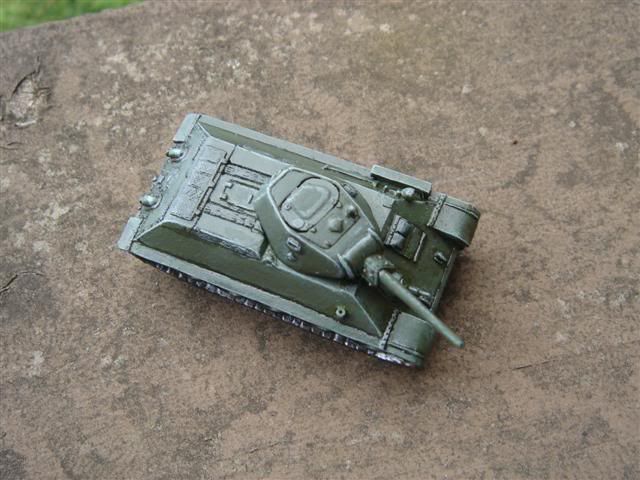
For the tankodesantniki I followed a similar process:
- Basecoat in Citadel's Black Primer
- Paint the appropriate colors using those suggested in the Stalingrad book for Flames of War
- Wash with brown "magic wash"
- Spray Testor's Gloss Cote for protection
- Spray Citadel's Matte Varnish for looks
I didn't make much effort to leave the basecoat showing as a shading effect, instead relying on the wash to achieve that. I was not completely happy with how this turned out, so when I decided to do some more infantry models I change the process just a little. That's a subject for a later post.
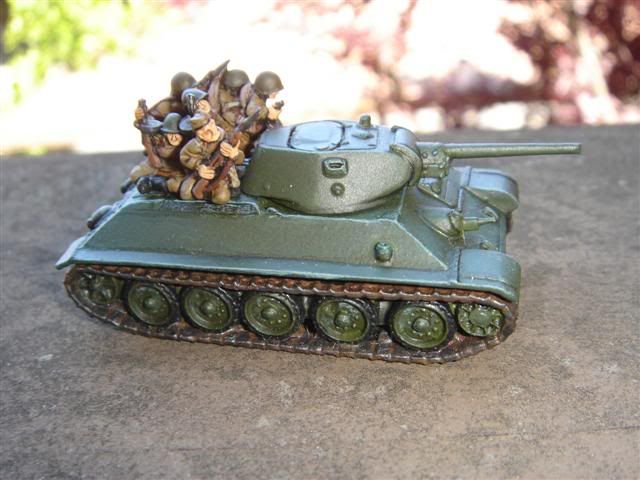
Continued in The Next Step
Friday, June 02, 2006
Corregidor
 I have something a bit different to post this time. Back in January of this year I was lucky enough to get a chance to visit Corregidor in the Philippines. The last holdout of American forces in the Philippines after the invasion by Japan during WWII, it's now a Philippine National Park. Located on the Island are the remains of batteries, barracks and shelters from the war, as well as memorials and a rather nice museum honoring those who fought. In addition, the island itself is beautiful and hosts a single hotel and restaurant for those who want to make an overnight trip.
I have something a bit different to post this time. Back in January of this year I was lucky enough to get a chance to visit Corregidor in the Philippines. The last holdout of American forces in the Philippines after the invasion by Japan during WWII, it's now a Philippine National Park. Located on the Island are the remains of batteries, barracks and shelters from the war, as well as memorials and a rather nice museum honoring those who fought. In addition, the island itself is beautiful and hosts a single hotel and restaurant for those who want to make an overnight trip.Visits to the island are handled mainly by a contracted tour operator that runs a ferry service and operates the hotel on the island. Basic packages include either a day trip or an overnight visit. Both include a guided tour, but the overnight stay gives you a good deal of time to explore the island on your own outside of the tour.
My fiancee and I only got to take the day trip, but we're hoping to have the chance to go back and stay overnight.
The island was originally fortified by the Spanish to protect Manila Bay. When the US took over they further strengthened the defenses. It served as MacArthur's headquarters during the fighting in Bataan, and when Bataan fell Corregidor became the last outpost of American forces in the Philippines until forced to surrender after the Japanese landed forces on the Island.
When US forces returned to the Philippines, the island was recaptured with a combined airborne and amphibious operation. The tour guides point out bullet holes and grenade shrapnel damage around some of the ammunition bunkers where the Japanese holed up and had to be dug out by the Americans.
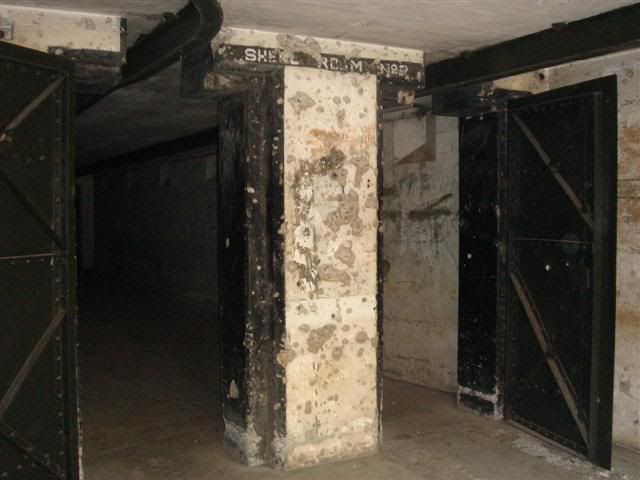
Most of the pre-war structures are in ruins having been destroyed by the Japanese shelling of the island during the siege. The underground bunkers and the guns themselves are in the best condition.
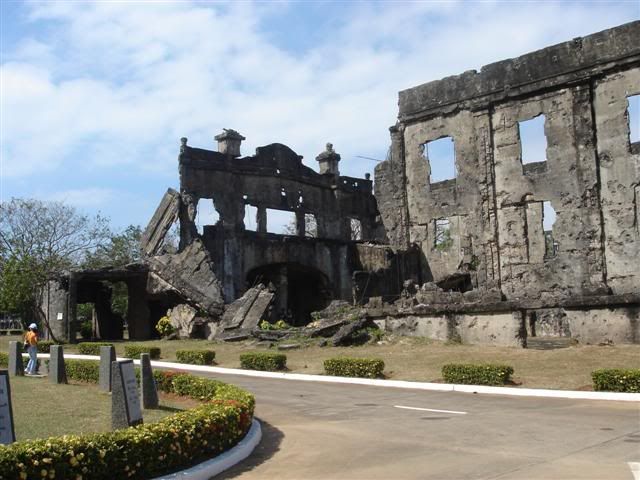
Some of the batteries we saw on the tour included the 12 inch gun in Battery Hearn, the four 12 inch mortars in Battery Way, and the two 12 inch "disappearing" guns in Battery Crockett, and their 10 inch counterparts in Battery Grubbs.
The gun in Battery Hearn is the largest on the island.
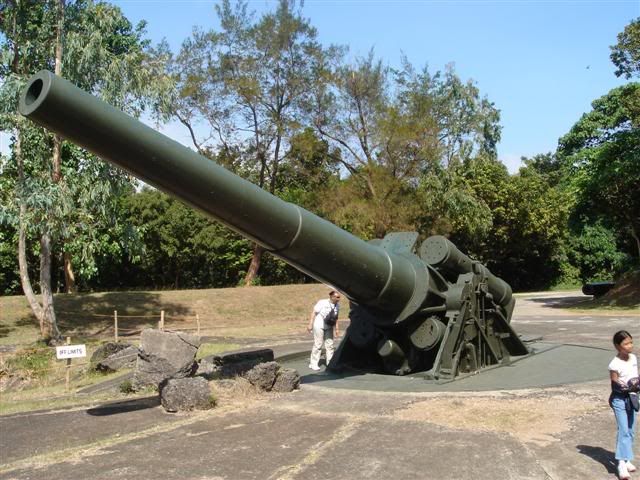
The mortars in Battery Way were considered obsolete by the time of the invasion and had recently been decomissioned, but were quickly brought back into action after the invasion began.
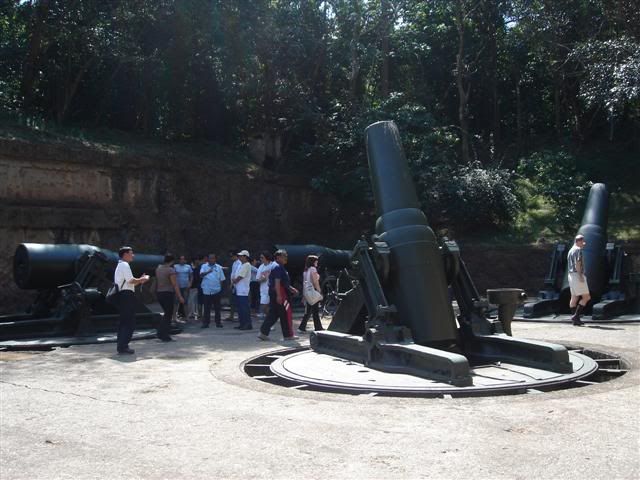
The guns in Battery Crockett and Grubbs were considered to be "disappearing" guns because they were mounted on elaborate carriages that raised the gun above its protective emplacement for firing, and then lowered it back down for reloading.
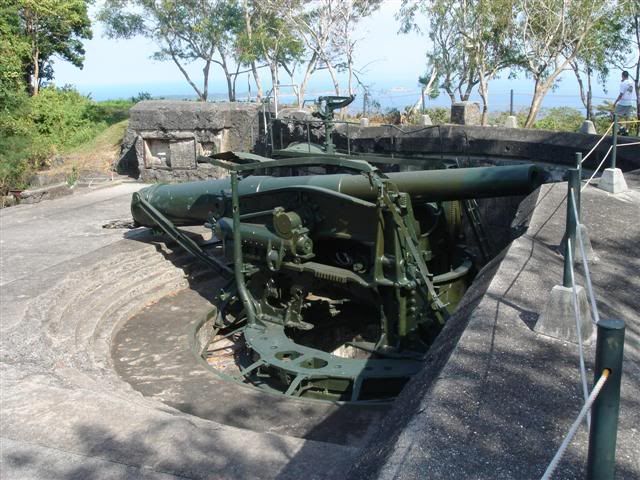
I highly recommend visiting if you are ever in the Philippines. The scenery is beautiful, and should entertain any travelling companions you have who aren't as interested in the history. I also recommend getting a copy of The 25 Best World War II Sites, Pacific Theater : The Ultimate Traveler's Guide to the Battlefields, Monuments and Museums
New Link: Alibris
If you've been reading this site, then I'm sure you've noticed the link to Amazon on the right. I have it there because I'm a satisfied customer of Amazon and their program is a way for me to hopefully get a few bucks back in exchange for the time I put into this site.
The problem is that Amazon doesn't always have what I'm looking for, especially if what I'm looking for is an out of print book. That's why I'm putting up the Alibris link. Alibris is a site that acts as a single online storefront for a host of used book stores around the world. I have only used them once so far, but was very satisfied with my purchase and plan on using them again soon.
I will be reviewing some out of print books on this blog, so if you end up interested in any of them, now you should have a way to track them down.
The problem is that Amazon doesn't always have what I'm looking for, especially if what I'm looking for is an out of print book. That's why I'm putting up the Alibris link. Alibris is a site that acts as a single online storefront for a host of used book stores around the world. I have only used them once so far, but was very satisfied with my purchase and plan on using them again soon.
I will be reviewing some out of print books on this blog, so if you end up interested in any of them, now you should have a way to track them down.
Subscribe to:
Posts (Atom)